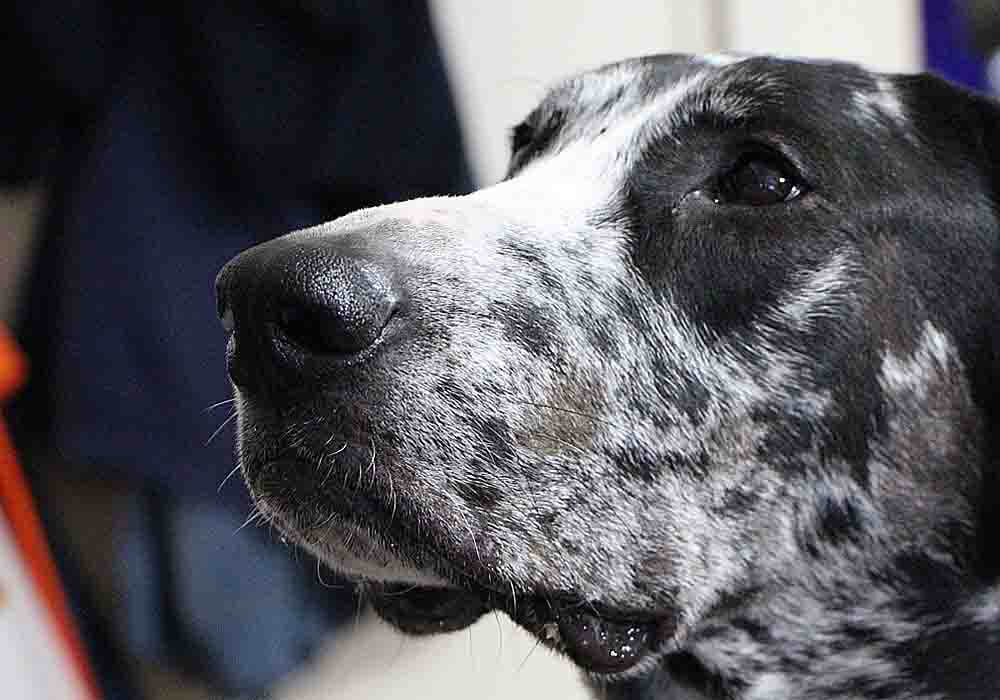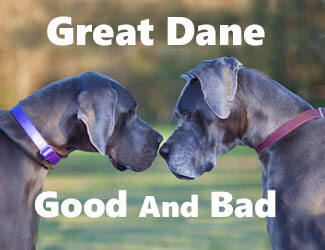Why Are Great Danes
Scared of Everything?
What Makes Them So Afraid?
by Ken Alden
Why are Great Danes scared of everything it seems? While all dogs can experience occasional anxiety, Great Danes tend to be more skittish than others. What causes this sudden fearfulness, and how should you help calm your dog when they are upset?
Why Are Great Danes Scared Of Everything?
Great Danes are scared of everything because they mature more slowly than most other dogs and are more vulnerable as puppies. They typically go through three fear stages as opposed to the usual two. Additionally, they become very attached to their owners, so separation anxiety is common at all ages.
Keep reading to learn more about Great Danes’ anxious tendencies and what you can do to properly socialize your dog to prevent skittishness and aggression.
Pro-tip: Ever try lifting a Great Dane? Their weight can hurt not only your back but their joints when they hop down from cars, sofas or even your bed. To protect your back and theirs check out the best Mastiff ramps on Amazon.com now.

Do Great Danes Have Anxiety?
Despite their enormous size and fearsome appearance, Great Danes are gentle giants who love their families intensely and develop close bonds with them. While you can certainly train them as fierce guard dogs, they’re very emotionally sensitive at heart and prefer to be near their owners as much as possible.
Their heightened emotional sensitivity makes them more attuned to their surroundings, which means they tend to be more fearful and develop severe separation anxiety if left alone for long periods.
These dogs don’t like changes in their environments. Without proper training and socialization, they can be very skittish, easily upset, and even prone to inappropriate aggression.
Abuse or traumatic experiences can also cause fearfulness and aggressive behavior in Great Danes, while their strength and large size can make this behavior especially dangerous..
Additionally, while they physically grow in size very quickly, they mentally and sexually mature more slowly than most other dogs, contributing to longer and more difficult fear periods as puppies. Why are Great Danes scared of everything
Most dogs experience two fear periods or stages as puppies. These fear stages are developmental periods where your puppy learns about their environment and how to interact with their surroundings. This can be very frightening for young dogs, who may randomly exhibit fear towards things, people, or places they weren’t afraid of before.
Pro-tip: Great Dane anxiety, aggression, destructive chewing, jumping up, fearfulness, and other behaviors can be controlled with the right training program.
Here’s a great course that
addresses these issues along with many other dog training basics: Check it out now!
Great Dane Fear Stages
The first fear stage usually occurs upon bringing a new Great Dane puppy home or when the dog is roughly two months old. While some training will be necessary during this stage, you need to minimize exercise while your dog adjusts to its new environment.
Give your dog lots of positive reinforcement when they are two to four months old to help build their confidence.
You may find that, during this stage, your Great Dane puppy displays fear towards the most mundane and nonthreatening of objects, such as your television, certain toys, or anything that makes loud or sudden noises or movements.
Avoid socializing your puppy with other dogs at this point, and keep them away from crowded areas, as overstimulation will worsen their fear and anxiety. Monitor them closely for signs of distress, such as:
- Putting their ears back or flat against their head
- Panting
- Trembling
- Freezing
- Eyes widening to where you can easily see the whites of their eyes
- Snapping or nipping
The second fear stage usually takes place when your puppy is anywhere from 6 to 12 months old. At this point, your dog has gained some understanding of their environment and is beginning to settle into their new home. However, they’re still experiencing rapid emotional and physical development, which can be stressful and fear-inducing.
During the second stage, you can start implementing more strict training and socialization around other dogs, people, and animals. Don’t be discouraged if your puppy is experiencing the same fears they had in the first fear stage all over again; this is normal and to be expected with most dogs.
Your Great Dane puppy will be going through several growth spurts during their second fear stage, and their changing bodies will contribute to their nervousness at this time.
Don’t coddle your dog in either fear stage, as sympathizing with them will only reinforce their fears. It might feel cruel or challenging to ignore your dog’s fearfulness, but by not overreacting to their anxiety, you’ll convince them that there’s nothing to fear.
Finally, Great Danes are unique in that they tend to experience a third fear stage when they reach sexual maturity. Not all Great Danes experience this stage, but if they do, it typically takes place when they are around 14 to 18 months old.
During this stage, lots of training, socialization, and positive reinforcement are crucial for your dog’s development. You can think of your dog as an older teenager in the third fear stage, as they will tend to try to push boundaries and see what they can get away with.
Be diligent with training moving forward, and don’t let your dog bully or dominate you during the third fear stage. Your Great Dane will be almost full size at this point, so they may try to use their weight to their advantage when misbehaving.
Pro-tip: Great Dane's (and their owners) love dog crates…and for good reasons. Crates keep dogs from mischief while you're away, are perfect for house training, for traveling by car, and provide the dog a place to de-stress. Check out the best Mastiff crates on Amazon.com now.
Great Dane Puppy Fear
Overall, Great Dane puppies experience longer and more stressful fear stages than most other breeds of dogs, but they’re still manageable with proper training and persistence.
Don’t reinforce your dog’s fears. Ignore their reactions and act like there’s nothing to be afraid of, as generally, their fearfulness is inappropriate and unnecessary.
Your Great Dane will take a bit longer to mature mentally and emotionally than other breeds, especially smaller ones. So, be patient with them as they gradually grow into adulthood.
Additionally, keep an eye out for signs of separation anxiety, as Great Danes are especially prone to fearfulness when separated from their owners or families, even for short periods.
If you start training your Great Dane early on, at around 5 to 6 months of age, their fearfulness will be much more manageable than if you were to wait until they become an adult.
Socialize them carefully and slowly with other people and animals in your home to build their confidence over time and reassure them their fears are unfounded.
At What Age Do Great Danes Calm Down?
Unfortunately, there’s no definitive answer for this, as it varies significantly depending on your dog’s genetics, personality, and how well you handle their fear periods as a puppy.
In general, though, Great Danes tend to calm down after reaching sexual maturity, or anywhere from 1.5 to 2 years old.
With any puppy, you’re going to experience high levels of energy and a general mischievousness. Great Danes mature more slowly than most dogs and don’t reach full adulthood until they’re nearly two years old, so be prepared for rambunctious, puppyish behavior throughout their first two years of life.
How To Get My Great Dane To Calm Down
Patience, diligence, and persistence are vital to getting your Great Dane to calm down as they age and mature. Look into obedience training as early as possible, but don’t start regular training until your puppy is out of their first fear stage, as you don’t want to overwhelm them.
If your Great Dane is an adult and still struggling with anxiety and fearfulness, don’t fret; you still have plenty of time and resources to help them calm down. Avoid leaving your dog alone for long periods if possible, and give them plenty of toys and try to keep their environment calm and quiet whenever you can.
Be consistent with positive reinforcement to build your dog’s confidence. Don’t reward your dog for displaying inappropriate anxiety or fearfulness.
Additionally, never reinforce their fears. If your dog displays nervousness towards a particular place, person, animal, or object, don’t indulge them or behave as if their fear is justified. Ignore their reaction and press on, showing your dog they have nothing to be afraid of.
If your Great Dane still has anxiety as an adult after extensive training and reinforcement, contact a qualified veterinarian to get to the bottom of the issue and rule out any potential health problems influencing their behavior.
Why Are Great Danes Scared Of Everything?...Final Thoughts
Many Great Dane owners are surprised to learn that their dogs are sensitive and timid despite their large size and intimidating appearance. Because they’re so emotionally delicate and mature more slowly than most dogs, their fear stages are longer and more difficult to deal with.
Thankfully, nervous and fearful behavior in Great Danes is manageable and possible to overcome with rigorous training and early, consistent socialization. Be proactive with handling your dog’s fear stages early on to ensure their fearful behavior doesn’t persist into adulthood.
Return to the top of this Why Are Great Danes Scared Of Everything page

About the Author...
Ken Alden, a dedicated Mastiff owner for over eight years, is acclaimed for his expertise in care, grooming, and training. Read more About Me and my dog Shadow.
- Mastiff Guide Home ›
- Great Danes Info ›
- Why Are Great Danes Scared Of Everything?





